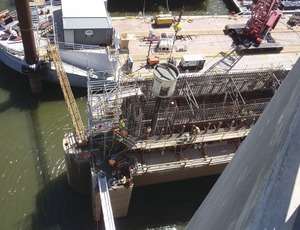
The quest for the first major water-resources bill in six years has cleared a key hurdle with House passage of an $8.2-billion measure that would authorize 23 new Corps of Engineers water projects, speed their regulatory reviews and boost funds for dredging.
The House's 417-3 vote on Oct. 23 clears the way for negotiations between that chamber and the Senate, which passed its Water Resources Development Act, or WRDA, in May. Amy Larson, National Waterways Conference president, says, "I think both chambers really would like to see a WRDA bill, so I think there'll be a willingness to find a middle ground." Steve Hall, American Council of Engineering Companies (ACEC) vice president for government affairs, says, "We are guardedly optimistic."
John Doyle, special counsel with law and lobbying firm Jones Walker LLP, says, "There is remarkable similarity, policy-wise, between the two bills." Though by no means identical, both measures have provisions aimed at accelerating Corps projects' environmental reviews. Hall says, "All of the complaints that the House and Senate members have heard [regarding] the length of time it takes some projects [to get reviewed], particularly large projects, have gotten the ear of Congress." Both bills also would hike annual Harbor Maintenance Trust Fund spending on dredging.
Both bills would trim the Inland Waterways Trust Fund's current 50% share to build the Olmsted Lock and Dam project, whose estimated cost has soared to $3.1 billion, from $775 million in 1988. The Senate bill cuts the project's future trust-fund share to zero, requiring the general fund to cover the remaining tab. The House measure slices the project's trust-fund share to 25%. One result would be to free more trust-fund money for other projects around the country.
There are some big differences between the bills, however. Doyle points to the wide spread between their price tags. The Congressional Budget Office pegs the House bill's 10-year cost at $8.2 billion and the Senate's at $12.2 billion. Funds are subject to annual appropriations. The House bill also would de-authorize $12 billion in long-inactive projects, says Transportation and Infrastructure Committee Chairman Bill Shuster (R-Pa.).
Another sticking point may be the Senate's proposed new Water Infrastructure Finance and Innovation Act loan program for Corps and Environmental Protection Agency projects. Groups such as ACEC want to keep it in the final bill. But House Republicans may balk at its scope and $500-million, five-year cost.
Neither chamber had appointed its negotiating team by ENR press time, and the House will be in recess until Nov. 12. In the meantime, House and Senate staffers are expected to lay the groundwork for a compromise final bill.



Post a comment to this article
Report Abusive Comment